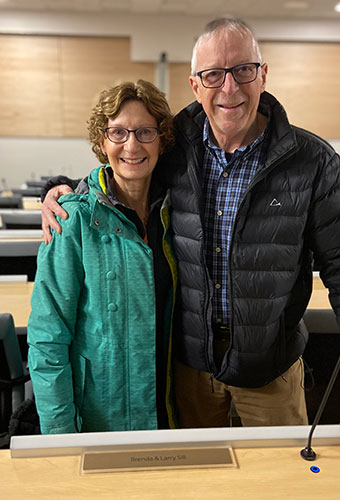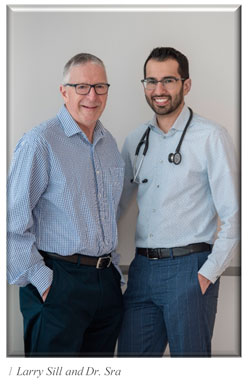Stories
I

LARRY SILL
After retiring as a Manager at Weyerhaeuser, Larry was enjoying retirement. Physically fit and trim, Larry could not complain of any health issues. But when he started having strange recurring symptoms in and around his throat area, he went to see his family doctor right away.
With a new system in place in Kamloops, a family physician is able to call a cardiologist right away when suspecting cardiac issues with a patient. Larry’s doctor did just that and a few days later, Cardiologist Dr. Sra saw Larry at the Rapid Access Care Clinic at RIH. Following an interview with Dr. Sra on his medical history, family history and overall lifestyle, Larry started a stress test at the clinic, but was stopped part way through when the nurse noticed abnormalities. Dr. Sra also had a look and decided Larry needed to go to the Kelowna General Hospital (KGH) for an angiogram.
While Larry was waiting for his appointment in Kelowna, he wore a Holter for 24 hours to monitor his heart activity. 10 days later and still waiting to go to Kelowna, Larry woke up in the middle of the night with upper chest discomfort. He ignored it at first, but then he started to feel sweaty and clammy. He knew that these were typical symptoms of a heart attack. His wife, Brenda, immediately called 911 and they had him chew four baby aspirins. The Fire Department arrived first to do an initial examination, followed by the ambulance and paramedics. By this time, Larry was starting to feel better, and when a second ambulance that was able to do an EKG arrived and hooked Larry up, he showed a normal EKG. As a result, he was told that it was not necessary for him to go to the hospital, but not wanting to take any chances, Larry decided to go to RIH by ambulance.
In the Emergency Department, staff did blood tests for Troponin (a group of proteins that help regulate the contractions of the heart and are released into the bloodstream following a heart attack), one test at the beginning and another four hours later. Shortly thereafter, Dr. Sra arrived and had a look at Larry’s file, concluding that Larry had suffered a heart attack. Larry was then admitted to the Cardiac Unit. “I was so grateful that Dr. Sra came in every day to give me an update on my current condition, expected admitting time to KGH, and to check on how the drugs they were giving me were working,” Larry stated.
A few days later, Larry did make the trip to KGH, where he was admitted to the Catheter Lab and underwent the angiogram procedure. “From when I arrived in the ambulance and was wheeled in to the Cath Lab, everything was so fast and efficient. Once I was prepped for the procedure the Doctor let me know that I was going to feel a small sting and some very minor chest discomfort. And then they were done!” he explained. During the procedure, blood was temporarily blocked off to specific arteries and a drug eluting stent was placed at the point of blockage in the LAD artery, also known as the ‘widow maker’ artery. Interestingly, for transport back to RIH a special bandage was put on Larry’s wrist where the incision had been made. Air was withdrawn gradually to keep pressure on the point. The result was that Larry required no stitches, and today one cannot even see where the incision was made.
Larry was returned to RIH the same day and after an overnight stay, was discharged. He is on medication to deal with his specific heart issue and follows a very structured plan he was given on what he needs to do and when. The number of medications is probably one of the biggest adjustments, since he went from taking no medications to taking four different meds, all intended to help his heart heal. For instance, Ticagrelor is a drug that he must take every 12 hours for a minimum of a year after the procedure, in order to prevent platelets developing over the stent. Larry also carries nitroglycerin with him. In addition to Dr. Sra, Larry has also seen Dr. Chu and Dr. Pun at the V.I.P. clinic, and he raves about the set-up in Cardiology where all doctors share all patients. “It is so much better for the patient, makes for a stronger overall system, and results in better patient care,” he emphasized.
Importantly, Larry is part of the Vascular Improvement Program (VIP) at RIH, which offers individualized education, health management counselling and specialized medical care to patients who have had a heart attack, stroke, bypass surgery, angioplasty, and artery or heart problems. Included are seminars related to cardiac care and a structured exercise program; patients are expected to do 150 minutes of targeted exercise per week. As part of his exercise routine with VIP, Larry participates in a 12-week program at the Tournament Capital Centre. Health professionals at TCC help with monitoring, goal setting and weekly exercise routines. This includes stretching, warm up, graduated exercise programs, and also blood pressure, oxygen level and pulse checks. Since Larry is so physically fit, he has been moved to the advanced section and uses treadmills and other equipment. Once he graduates from this program, he has the option of doing a graduate program run by the City of Kamloops through the Strategic Health Alliance partnership.
“Kamloops and the surrounding area is so fortunate to have the emergency services and medical professionals that we have. Any of these professionals could easily transfer their skills to another health region, but the y chose Kamloops; we should all be grateful. I was very fortunate, not only for the great care that Dr. Sra and the team gave me, but also to have the loving support of my wife and family.” Larry concluded.
If you are a patient or family member and would like to share your story, we would love to hear from you! You can either fill in the form or contact our office at 250-314-2325.


